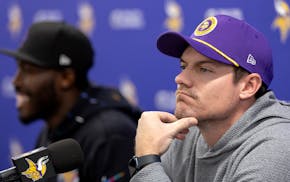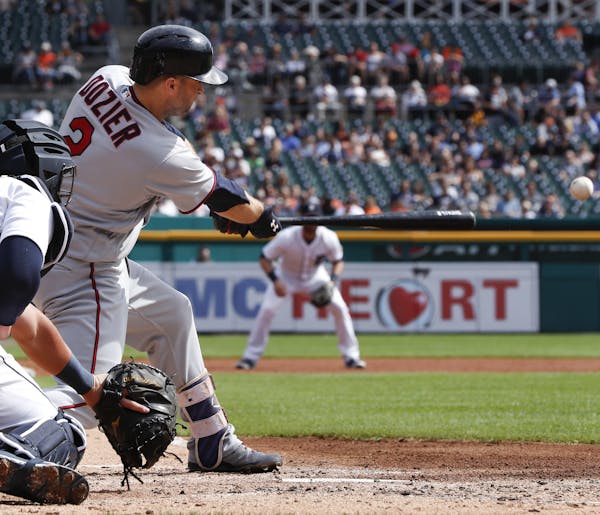"Buxton's Day Arrives," blared the 60-point headline in this newspaper the morning of Byron Buxton's major league debut 15 months ago, a display of anticipation rare for a rookie. And while a smaller headline right below it warned "Expect him to struggle some," it's not clear anyone believed it.
They do now.
Buxton, rated the best prospect in the sport in both 2014 and 2015, has experienced the introduction to the major leagues that hundreds of players before him have endured: Confidence-shaking strikeouts, morale-eroding slumps, humbling demotions and an array of adjustments made in the hope that the minor league success that felt so preordained and inevitable can be recaptured on a bigger stage.
There's no doubt that Twins fans, thirsting for positive news amid a years-long decline, are disappointed that a player billed as the franchise's own Mike Trout or Bryce Harper has not stormed his way to a Rookie of the Year award, or even MVP. But there's even less doubt that those expectations always were unfair to a barely-old-enough-to-shave novice.
"It's not unusual for projections to outstrip reality at first with younger players, especially someone with the buildup he's received," Twins manager Paul Molitor said of his still-a-rookie center fielder. "The talents he has — I don't want to say it's a burden, but the extra attention a player like him is afforded, particularly with all the focus on minor leagues that didn't used to exist, can give the impression that success is a given right away. That's not the way it works, with very few exceptions."
Well, maybe it is a burden. Buxton himself has grown used to being asked about his difficulties hitting the ball hard against pitchers with far more experience than he has — the 22-year-old Georgian has yet to face a major league pitcher younger than he is. And he has remained unflaggingly optimistic, at least publicly, about learning his craft in a bright spotlight.
"I'm feeling more comfortable all the time," Buxton said earlier this month, after his fourth call-up from the minor leagues. "I know what [pitchers] are trying to do to me, and I'm making the adjustments."
Specifically, he has adopted a small leg kick during the pitcher's windup, he said, a timing device that he frequently used in the minors, but abandoned for awhile in the majors in hopes that less movement would mean better vision as the pitch approaches. "It's a small thing, but it [adds to my] comfort level at the plate," Buxton said. "It starts my swing earlier."
By doing so, Buxton hopes to get his bat into the strike zone more quickly, addressing one of his most nagging problems: making contact. Only 67.9 percent of his swings connect with the pitch, according to fangraphs.com's calculations, ranking him among the bottom 20 hitters in the majors. (An average hitter connects on roughly 80 percent of his swings.) That, and the fact that he swings at 34 percent of pitches outside the strike zone, helps explain Buxton's 35.8 percent strikeout rate, which is third highest in the game among players with 200 plate appearances.
"His swing path and swing plane has been problematic over the last year. He had the most natural, flattest, controlled swing ever coming up, but as he's gotten bigger, as he's faced better pitchers, as he's tried to handle breaking balls, his swing plane was not in a good place," said Mike Radcliff, the Twins vice president of player personnel. "That's normal for a young hitter, and it's gotten a lot better now."
That swing has produced six home runs in 17 September games, or two-thirds of his career total, not to mention five other extra-base hits. "He's making harder contact," Molitor said. "He's been able to drive the ball more than we've seen before."
Starting earlier might also eventually allow Buxton to address one other major obstacle: inside pitches. Buxton has been unusually vulnerable to anything on the inside of the plate, and also pitches down and away. It's not unusual for rookies, but it seems particularly pronounced in Buxton's case.
"Torii Hunter had one of the fastest bats I've seen, but he was always afraid he'd get beat inside, that he'd get jammed," Radcliff said. "That's a pitch a lot of hitters worry about, but he has the ability to handle it. We've seen [him do] it, but he just needs the confidence to protect the inside half."
Buxton, in fact, has swung at 96 pitches on the inside third of the plate this season (and taken 41), according to MLB's pitchf/x data, but only 31 of them were put in play. Of those, he collected only six singles and a double. By contrast, Brian Dozier has swung at 125 pitches on the inner third — and knocked 13 of them out of the park, along with eight doubles and 11 singles.
Buxton eventually will punish those pitches, too, the Twins believe. It's a matter of confidence, and of asserting himself on hitter's counts — which is something he has yet to do, to a bizarre degree.
A 2-0 count is a huge advantage for a hitter, and the same for 3-1; in both cases, the combination of pressure on a pitcher and the freedom to swing for a hitter combine to produce plenty off offensive fireworks: A .986 OPS for all American League hitters this season after 0-2 counts, a 1.069 OPS once it's run to 3-1. It's a license to smack extra-base hits.
Not for Buxton, though. He has gotten ahead 2-0 in 38 plate appearances this season and has reached 3-1 on 18 occasions (there's some overlap, obviously). And given those opportunities, he has, amazingly, exactly one hit to show for it. In fact, even spotted a 2-0 count, Buxton is still more likely to strike out (11) than walk (10). His .338 OPS after getting ahead 2-0 is about one-fourth that of fellow rookie Max Kepler's 1.269 OPS.
By contrast, Buxton has 11 hits — including four home runs — after falling behind 0-2, something he has done 78 times this season.
Those oddities mostly illustrate the randomness of such relatively tiny sample sizes, of course; Buxton has had the equivalent of four months' worth of plate appearances in the majors, and Molitor emphasizes that fact.
"The difference between what you've experienced before you get to the big leagues and what it takes to achieve your potential here, I don't know that you can understand it ahead of time," Molitor said. "That process is a little different for everybody."
For Radcliff, who has scouted Buxton since he was a high school star in Baxley, Ga., "it comes down to two words: confidence and trust. He's got all kinds of great ability, from head to feet, and he just needs to apply it. And the only way to do that is through trust and confidence. … It's a game of failure, and you have to overcome that mental hurdle. We're starting to see it now, and he'll be better next year and the year after that."
Minnesota's Naz Reid wins NBA's Sixth Man of the Year award, edging Malik Monk in close vote

